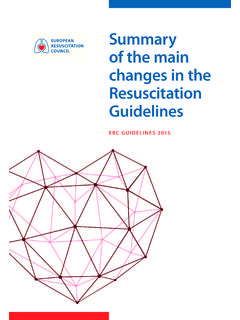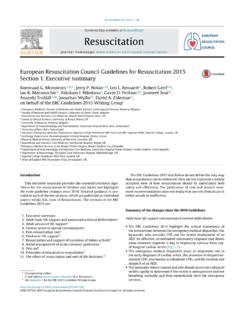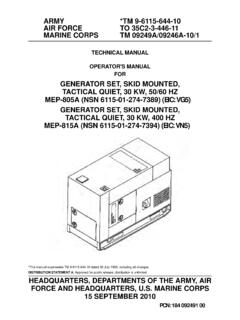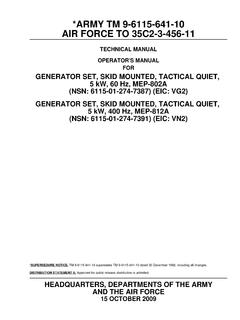Transcription of 120 Abdominal compartment syndrome - FRCA
1 Abdominal compartment syndrome TUTORIAL OF THE WEEK NUMBER 120 1ST DECEMBER 2008 William English, North Bristol NHS Trust, Bristol, UK Bruce McCormick, Royal Devon & Exeter Hospital, UK SELF-ASSESSMENT QUESTIONS Please read the following questions. The answers will be found in the main text. 1. What is the normal pressure within the abdomen? 2. Define intra- Abdominal hypertension and Abdominal compartment syndrome . 3. List the common predisposing causes of Abdominal compartment syndrome . 4. What organ systems can be affected by raised intra- Abdominal pressure?
2 5. Describe one method for estimating intra- Abdominal pressure. 6. Discuss the indications for surgical intervention in Abdominal compartment syndrome . INTRODUCTION Abdominal compartment syndrome is a condition associated with significant morbidity and mortality. This article includes a case summary of a patient who developed this condition, after which the pathophysiology, diagnosis and management of this important condition are discussed. Self assessment questions are provided. CASE SUMMARY A 26-year-old previously fit and well man was a pedestrian involved in a road traffic accident.
3 His injuries included rib fractures, a ruptured spleen and an unstable pelvic fracture. He was admitted to the intensive care unit following external fixation of his pelvis, laparotomy and splenectomy. Estimated blood loss was over 4 litres, which was replaced with a combination of blood, fresh frozen plasma and platelets. At the end of the case the patient had a metabolic acidosis, a mild coagulopathy, mild anaemia and was hypothermic. In view of these findings the patient remained ventilated and was admitted to the ICU.
4 Overnight the coagulopathy, anaemia and hypothermia were corrected. However his ventilatory requirements increased, with peak inspiratory pressure rising from 22cmH20 to 38cmH20 in order to maintain acceptable tidal volumes. In addition his base excess remained greater than and his urine output remained less than despite fluid resuscitation. His abdomen was noted to be tense and distended and at this stage a clinical diagnosis of Abdominal compartment syndrome was suggested. Abdominal compartment syndrome was confirmed by measurement of his intra- Abdominal pressure.
5 This was measured via an intra-vesical catheter, a technique described later, and a reading of 28cmH20 was obtained. Following discussion with the surgical team the decision was made to undertake decompressive laparotomy. On opening the abdomen peak inspiratory pressures fell immediately. No active bleeding was found but large intra- Abdominal and retro-peritoneal haematomas were evacuated. Primary Abdominal closure was not possible. Temporary closure was achieved using part of a sterile opened intravenous fluid bag, stitched to the Abdominal wall.
6 The patient was then returned to the ICU, still ventilated but requiring much reduced ventilatory support. Subsequent progress was complicated by sepsis, secondary to ventilator associated pneumonia, but on day 7 he underwent closure of his Abdominal wound. Two days later he underwent internal fixation of his pelvic fractures and was discharged home one week later. DEFINITIONS The potential adverse consequences of raised intra- Abdominal pressure (IAP) have been recognised for many However the term Abdominal compartment syndrome (ACS) was not coined until 1984, when Kron et al.
7 Published a series of post-operative patients in whom they measured Recently the definitions of intra- Abdominal hypertension (IAH) and ACS have been IAH is defined as an intra- Abdominal pressure of 12mmHg or more. ACS is defined as an IAP above 20mmHg with evidence of organ dysfunction or failure. ACS is further classified as primary, secondary or recurrent. Primary ACS is associated with conditions within the abdominopelvic region. Secondary ACS includes conditions that do not originate within the abdomen, such as sepsis and capillary leak, major burns or other conditions that require massive fluid resuscitation.
8 Recurrent ACS is a condition in which ACS recurs after treatment of primary or secondary ACS. PATHOPHYSIOLOGY Intra- Abdominal pressure reflects the relationship between intra- Abdominal volume and Abdominal compliance and has a direct relationship with intra-thoracic pressure. The relationship between Abdominal pressure and volume is non-linear. Abdominal compliance is affected by speed of increase in Abdominal volume as evidenced by the slight changes in IAP that occur during pregnancy.
9 Normal IAP is estimated to be around 6mmHg. Chronic IAH can occur in some obese patients. The causes of acutely raised IAP are often multifactorial. Common causes of raised IAP Trauma and intra- Abdominal or retroperitoneal haemorrhage Abdominal surgery (including laparoscopy per-op) Peritonitis Repair of large incisional hernias Massive fluid resuscitation (> 5 litres per 24 hours) Small changes in IAP are usually well tolerated but as IAH worsens it will eventually affect regional blood flow and impair tissue perfusion.
10 This is often related to the systemic inflammatory response and multiorgan failure and the organ systems involved include the renal, cardiovascular, respiratory, gut, central nervous and immune systems. These will be discussed in turn. Renal effects of ACS Impairment of renal function seen in ACS is caused by an increase in renal vascular resistance caused by renal vein compression. Reduction in cardiac output may be another causative factor. The exact IAP required to cause renal impairment is not known but some authors suggest a level of above 15mmHg.

















